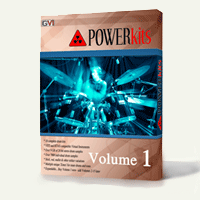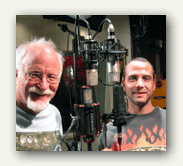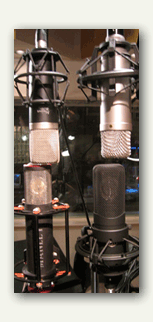

by Gary Powell
If you are ready for an entirely different method of keeping better time with your own internal clock, the Body Beat Pulsing Metronome may be just for you. This is the new millennium’s latest version of the good-ole metronome we have all grown to hate and which was only, and almost always, an annoying audio click or beep. Simply put, the  Peterson BB-1 Body Beat Pulsing Metronome changes the human interface of the metronomic beat from an aural experience to a vibratory one.
Peterson BB-1 Body Beat Pulsing Metronome changes the human interface of the metronomic beat from an aural experience to a vibratory one.
The greatest drummers have always had an exacting sense of time. For the rest of us, the Body Beat just may deliver a similar internal experience that these greatest human metronomes have always felt. It took just one full song for me to get used to the little pulsing vibrations of this machine and to be able to play in time with it. I’ve been listening and playing to clicks since 1970, so I was anxious to see if I could keep time at all without hearing the traditional click in my head. In my very first test, I found that I responded to the Body Beat best when the vibrator was attached to the sleeve of my T-shirt. As a pianist, this put the beat directly into the same appendage that was playing the music – my right arm! Yes, I do understand that the vibratory beat went to my brain first, then back down to the fingers, but it didn’t feel like that. I think I could get used to this and I’m positive that it could make me a tighter player without the annoyance of the audio click that seems to always rush or drag! (That’s an old musician’s joke first credited to Chet Atkins.)
Hopefully, future versions will have some kind of sync input for use in recording studios. Until then, this is a beautifully conceived and executed idea. Thank you, Christopher Parsons, President of DOT Music and the inventor of the Body Beat Metronome.


by Gary Powell
If you are ready for an entirely different method of keeping better time with your own internal clock, the Body Beat Pulsing Metronome may be just for you. This is the new millennium’s latest version of the good-ole metronome we have all grown to hate and which was only, and almost always, an annoying audio click or beep. Simply put, the  Peterson BB-1 Body Beat Pulsing Metronome changes the human interface of the metronomic beat from an aural experience to a vibratory one.
Peterson BB-1 Body Beat Pulsing Metronome changes the human interface of the metronomic beat from an aural experience to a vibratory one.
The greatest drummers have always had an exacting sense of time. For the rest of us, the Body Beat just may deliver a similar internal experience that these greatest human metronomes have always felt. It took just one full song for me to get used to the little pulsing vibrations of this machine and to be able to play in time with it. I’ve been listening and playing to clicks since 1970, so I was anxious to see if I could keep time at all without hearing the traditional click in my head. In my very first test, I found that I responded to the Body Beat best when the vibrator was attached to the sleeve of my T-shirt. As a pianist, this put the beat directly into the same appendage that was playing the music – my right arm! Yes, I do understand that the vibratory beat went to my brain first, then back down to the fingers, but it didn’t feel like that. I think I could get used to this and I’m positive that it could make me a tighter player without the annoyance of the audio click that seems to always rush or drag! (That’s an old musician’s joke first credited to Chet Atkins.)
Hopefully, future versions will have some kind of sync input for use in recording studios. Until then, this is a beautifully conceived and executed idea. Thank you, Christopher Parsons, President of DOT Music and the inventor of the Body Beat Metronome.
by Gary Powell

I’ve been using “Larry Seyer’s Acoustic Drums” library since its release for the GigaStudio platform in 2005! When programming drum samples is appropriate I have implemented Larry Seyer’s library with stellar success creating happy clients. Larry has now reformatted these same samples as a virtual instrument called POWERkits. It’s difficult to explain something as complex as all this in a non-technical way for my readers who are not studio geeks, so here goes anyway.
Larry and drummer Pat Mastelotto record individual drums hits on many different kinds of drums with many different kinds of sticks. Also, each drum head is struck in eight different zones spaced in concentric circles with each zone being recorded separately one hit at a time.  Also, drum strikes or hits are recorded at many different volume levels. This massive amount of information is then digitally edited, stapled, stamped, washed, rinsed and spun-dried into a “virtual” instrument meaning at the end of the process all these drum sounds can all be played on a digital piano (we call it a controller) with each drum hit having been assigned to a different key on the piano keyboard. These individual recordings are called “samples”. Still with me? Okay, then keep reading.
When you as the new drummer now play a “D” above middle “C” on your piano keyboard, you will trigger the software to play a snare drum. If you strike the key harder then the software is programmed to trigger a different “sample” which is actually a different recording Larry made when Pat simply hit the drum harder. If you understand this, then you might enjoy reading it with pictures from the master himself.
If you want to hear these sounds in action, then go to LarrySeyerDigital.com and click on the little play button at the top left side of the page.
What’s new about POWERkits is that these drum samples no longer require a separate software program or separate computer. Triggering samples recorded from eight different areas of each drum head is also innovative and new for all of us. These samples now live right within your own recording software environment, even on a laptop, ready to play on a moment’s notice. In the old days, we might have called this a “ram resident” application. Nowadays, it is simply called a “virtual instrument”! I have greatly simplified the process, but I hope it helps you understand the basics of sampling.
Recording great drum sounds has always been one of the last things an audio engineer masters. Larry Seyer has spent more than five years creating something unbelievably complex in making world-class drums sounds accessible to anyone with a laptop or computer regardless of being on either on the PC or Mac platform. Even though the whole of the professional recording industry uses “Larry Seyer’s Acoustic Drums”, this new virtual instrument version is priced to be available to recording enthusiasts at any level. The amazing thing is that this library is so immense and varied that even expert listeners, audiophiles and recording engineers will never identify these drum sounds as samples.
In typical fashion of a talented man who takes care of his customers, frequently asked questions about POWERkits are answered on Larry’s site.
by Gary Powell

I’ve been using “Larry Seyer’s Acoustic Drums” library since its release for the GigaStudio platform in 2005! When programming drum samples is appropriate I have implemented Larry Seyer’s library with stellar success creating happy clients. Larry has now reformatted these same samples as a virtual instrument called POWERkits. It’s difficult to explain something as complex as all this in a non-technical way for my readers who are not studio geeks, so here goes anyway.
Larry and drummer Pat Mastelotto record individual drums hits on many different kinds of drums with many different kinds of sticks. Also, each drum head is struck in eight different zones spaced in concentric circles with each zone being recorded separately one hit at a time.  Also, drum strikes or hits are recorded at many different volume levels. This massive amount of information is then digitally edited, stapled, stamped, washed, rinsed and spun-dried into a “virtual” instrument meaning at the end of the process all these drum sounds can all be played on a digital piano (we call it a controller) with each drum hit having been assigned to a different key on the piano keyboard. These individual recordings are called “samples”. Still with me? Okay, then keep reading.
When you as the new drummer now play a “D” above middle “C” on your piano keyboard, you will trigger the software to play a snare drum. If you strike the key harder then the software is programmed to trigger a different “sample” which is actually a different recording Larry made when Pat simply hit the drum harder. If you understand this, then you might enjoy reading it with pictures from the master himself.
If you want to hear these sounds in action, then go to LarrySeyerDigital.com and click on the little play button at the top left side of the page.
What’s new about POWERkits is that these drum samples no longer require a separate software program or separate computer. Triggering samples recorded from eight different areas of each drum head is also innovative and new for all of us. These samples now live right within your own recording software environment, even on a laptop, ready to play on a moment’s notice. In the old days, we might have called this a “ram resident” application. Nowadays, it is simply called a “virtual instrument”! I have greatly simplified the process, but I hope it helps you understand the basics of sampling.
Recording great drum sounds has always been one of the last things an audio engineer masters. Larry Seyer has spent more than five years creating something unbelievably complex in making world-class drums sounds accessible to anyone with a laptop or computer regardless of being on either on the PC or Mac platform. Even though the whole of the professional recording industry uses “Larry Seyer’s Acoustic Drums”, this new virtual instrument version is priced to be available to recording enthusiasts at any level. The amazing thing is that this library is so immense and varied that even expert listeners, audiophiles and recording engineers will never identify these drum sounds as samples.
In typical fashion of a talented man who takes care of his customers, frequently asked questions about POWERkits are answered on Larry’s site.
 by Gary Powell
by Gary Powell
Marty Lester (young guy on the right), audio engineer from the Austin production studio, Tequila Mockingbird, helped me compare four cardioid tube microphones;
As pictured – Top left: Mojave MA200 $1k (Mojave Audio) / Top right: Rode NTV $1k / Bottom Left: Manley Reference $2.7k / Bottom Right: AT-4060 $1.4k (Audio Technica)
This quest started when I heard an Austin CD engineered by Marty Lester back in 1999 for artist Robert Kraft. I thought this was maybe the best vocal sound I had ever heard recorded, so I called Marty to find out how he did it. The microphone was a Manley Reference recorded through an Avalon mic-pre.
I know the Rode NTV very well and have used it for years, so it was my standard by which to compare the three new contenders. The Mojave and NTV were run through the Drawmer 1960 mic pre. The Manley and the AT-4060 were run through the Peavey VMP2.
I’ll let Marty share his opinions in the comments, but I think we were in agreement. These are all tube microphones with a single cardioid pick-up pattern. Let me say first that each of these mics could be the perfect microphone for any particular singer. That said, without price being a factor, the newly released Mojave MA200 designed by David Royer was the clear winner.
That said, without price being a factor, the newly released Mojave MA200 designed by David Royer was the clear winner.
Mojave MA200 – This was like going to your local Ear, Nose and Throat specialist and having your ear wax removed and feeling like your ears hadn’t been in the studio for 30 years!
Rode NTV – A little boxy in the middle, but I’ve always loved it on “airy” singers prone to sibilance problems.
Manley Reference – That famous “grain” sound up top is wonderful, but I thought the mids were a little overpowered by it.
AT-4060 – Smooth through all the frequencies, but a little dark on the top. I should own this mic just for that one singer who would sound great on it.
Also, I compared the Neumann TLM103 against my AKG-414 ULS. After routing them both through the Drawmer 1960, I found them so similar that there was no discernable reason to purchase the Neumann as much as I liked it.
My special thanks to Marty Lester in bringing Tequila’s Manley and his excellent ears over to my studio. Also, thank you Jeffrey Green my Sweetwater sales engineer, for suggesting the Mojave and sending out so many mics.
 by Gary Powell
by Gary Powell
Marty Lester (young guy on the right), audio engineer from the Austin production studio, Tequila Mockingbird, helped me compare four cardioid tube microphones;
As pictured – Top left: Mojave MA200 $1k (Mojave Audio) / Top right: Rode NTV $1k / Bottom Left: Manley Reference $2.7k / Bottom Right: AT-4060 $1.4k (Audio Technica)
This quest started when I heard an Austin CD engineered by Marty Lester back in 1999 for artist Robert Kraft. I thought this was maybe the best vocal sound I had ever heard recorded, so I called Marty to find out how he did it. The microphone was a Manley Reference recorded through an Avalon mic-pre.
I know the Rode NTV very well and have used it for years, so it was my standard by which to compare the three new contenders. The Mojave and NTV were run through the Drawmer 1960 mic pre. The Manley and the AT-4060 were run through the Peavey VMP2.
I’ll let Marty share his opinions in the comments, but I think we were in agreement. These are all tube microphones with a single cardioid pick-up pattern. Let me say first that each of these mics could be the perfect microphone for any particular singer. That said, without price being a factor, the newly released Mojave MA200 designed by David Royer was the clear winner.
That said, without price being a factor, the newly released Mojave MA200 designed by David Royer was the clear winner.
Mojave MA200 – This was like going to your local Ear, Nose and Throat specialist and having your ear wax removed and feeling like your ears hadn’t been in the studio for 30 years!
Rode NTV – A little boxy in the middle, but I’ve always loved it on “airy” singers prone to sibilance problems.
Manley Reference – That famous “grain” sound up top is wonderful, but I thought the mids were a little overpowered by it.
AT-4060 – Smooth through all the frequencies, but a little dark on the top. I should own this mic just for that one singer who would sound great on it.
Also, I compared the Neumann TLM103 against my AKG-414 ULS. After routing them both through the Drawmer 1960, I found them so similar that there was no discernable reason to purchase the Neumann as much as I liked it.
My special thanks to Marty Lester in bringing Tequila’s Manley and his excellent ears over to my studio. Also, thank you Jeffrey Green my Sweetwater sales engineer, for suggesting the Mojave and sending out so many mics.
I’ve been a fan of GigaStudio since it first came out. I’ve also been working with Larry Seyer in the studio since 1978. He’s played guitar and/or mixed over 100 albums I’ve produced. The Larry Seyer Acoustic Bass library has been a staple with me for years and now he’s given us the Acoustic Drum Library. Check out his site and download the video demo which is a quick tutorial of the library all shot in my studio. The sounds are awesome and so is the interface.
I’ve been a fan of GigaStudio since it first came out. I’ve also been working with Larry Seyer in the studio since 1978. He’s played guitar and/or mixed over 100 albums I’ve produced. The Larry Seyer Acoustic Bass library has been a staple with me for years and now he’s given us the Acoustic Drum Library. Check out his site and download the video demo which is a quick tutorial of the library all shot in my studio. The sounds are awesome and so is the interface.
Peterson BB-1 Body Beat Pulsing Metronome changes the human interface of the metronomic beat from an aural experience to a vibratory one.


 by Gary Powell
by Gary Powell That said, without price being a factor, the newly released Mojave MA200 designed by David Royer was the clear winner.
That said, without price being a factor, the newly released Mojave MA200 designed by David Royer was the clear winner.